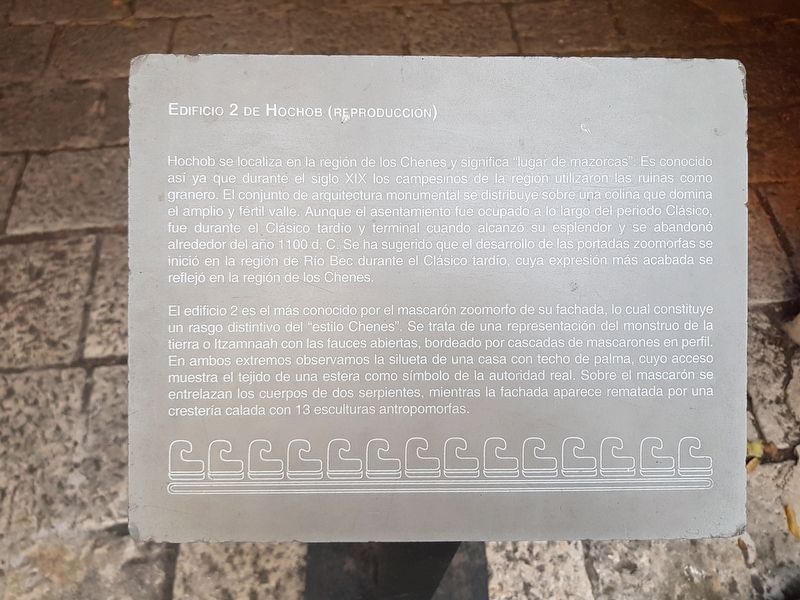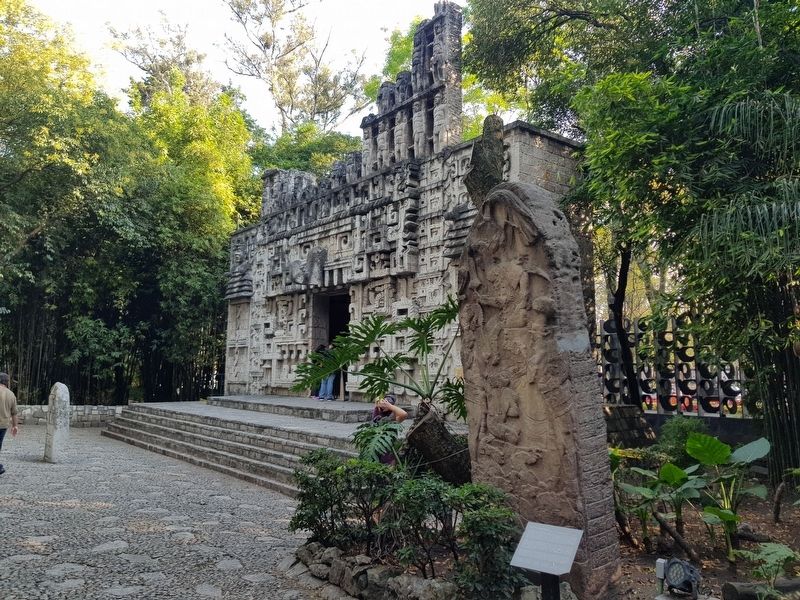Colonia Polanco in Ciudad de México, Mexico — The Valley of Mexico (The Central Highlands)
Hochob Building 2
Hochob se localiza en la región de los Chenes y significa “lugar de mazorcas”. Es conocido así ya que durante el siglo XIX los campesinos de la región utilizaron las ruinas como granero. El conjunto de arquitectura monumental se distribuye sobre una colina que domina el amplio y fértil valle. Aunque el asentamiento fue ocupado a lo largo del periodo Clásico, fue durante el Clásico tardío y terminal cuando alcanzó su esplendor y se abandono alrededor del año 1100 d. C. Se ha sugerido que el desarrollo de las portadas zoomorfas se inició en la región de Río Bec durante el Clásico tardío, cuya expresión más acabada se reflejó en la región de los Chenes.
El edificio 2 es el más conocido por el mascarón zoomorfo de su fachada, lo cual constituye un rasgo distintivo del “estilo Chenes". Se trata de una representación del monstruo de la tierra o Itzamnaah con las fauces abiertas, bordeado por cascadas de mascarones en perfil. En ambos extremos observamos la silueta de una casa con techo de palma, cuyo acceso muestra el tejido de una estera como símbolo de la autoridad real. Sobre el mascarón se entrelazan los cuerpos de dos serpientes, mientras la fachada aparece rematada por una crestería calada con 13 esculturas antropomorfas.
Hochob Building 2 (Reproduction)
Hochob is located in the Chenes Region and its name means "place of ears of corn." It is known by this name as during the nineteenth century the peasants of the region used the ruins as a barn. The area’s monumental architecture is distributed on a hill that dominates the wide and fertile valley. Although the settlement was occupied throughout the Classic Period, it was during the Late Classic and Terminal Periods when it reached its splendor and was abandoned around 1100 A.D. It has been suggested that the development of zoomorphic building facades began in the Rio Bec region during the Late Classic Period. The best example of these is reflected in the Chenes region.
Building 2 is best known for the zoomorphic symbolism of its facade, which constitutes a distinctive feature of the "Chenes style." It is a representation of the “land monster”, also known as Itzamnaah, with open jaws, bordered by waterfalls of masks in profile. At both ends we observe the silhouette of a house with a palm roof, whose entryway shows the fabric of a mat as a symbol of royal authority. On the mask entwine the
bodies of two snakes, while the facade is topped by an openwork crest with 13 anthropomorphic sculptures.
Topics. This historical marker is listed in these topic lists: Architecture • Native Americans.
Location. 19° 25.52′ N, 99° 11.206′ W. Marker is in Ciudad de México. It is in Colonia Polanco. Marker is on Avenida Paseo de la Reforma, on the left when traveling east. The marker and reproduction building are on the grounds of the National Anthropological Museum of Mexico, south of the main building of the museum. The marker can only be seen by entering the museum grounds. Touch for map. Marker is in this post office area: Ciudad de México 11100, Mexico. Touch for directions.
Other nearby markers. At least 8 other markers are within walking distance of this marker. Ek Balam Building 1 (a few steps from this marker); Stela 6 of Piedras Negras (a few steps from this marker); Stela 12 of Piedras Negras (within shouting distance of this marker); Stela E of Quiriguá (within shouting distance of this marker); Bonampak (within shouting distance of this marker); Monolith of Coatlinchán (about 210 meters away, measured in a direct line); The National Anthropology Museum of Mexico (about 240 meters away); The Large and Small Lakes at Chapultepec (approx. half a kilometer away). Touch for a list and map of all markers in Ciudad de México.
Credits. This page was last revised on April 17, 2020. It was originally submitted on February 2, 2020, by J. Makali Bruton of Accra, Ghana. This page has been viewed 96 times since then and 6 times this year. Photos: 1, 2. submitted on February 2, 2020, by J. Makali Bruton of Accra, Ghana.

